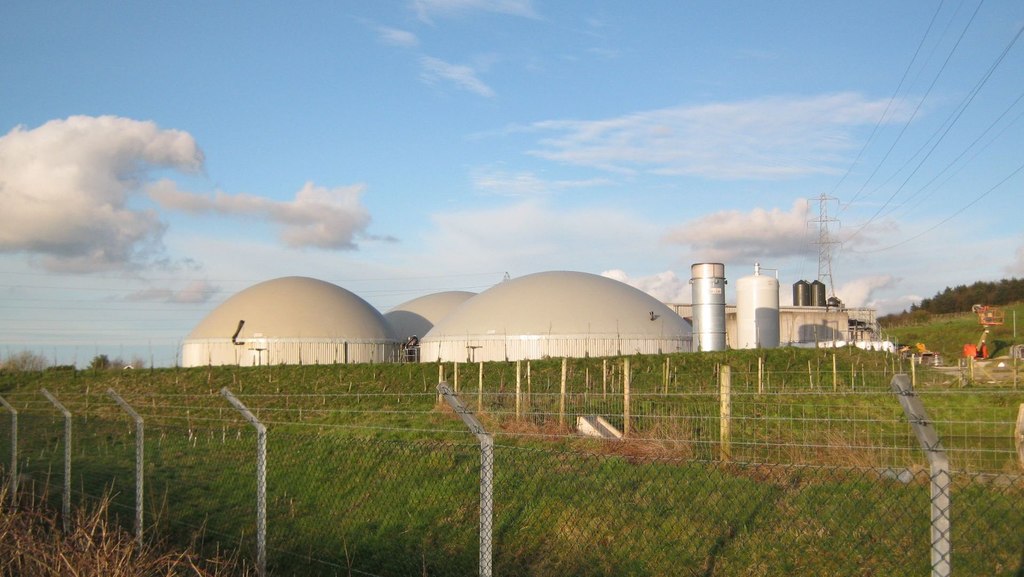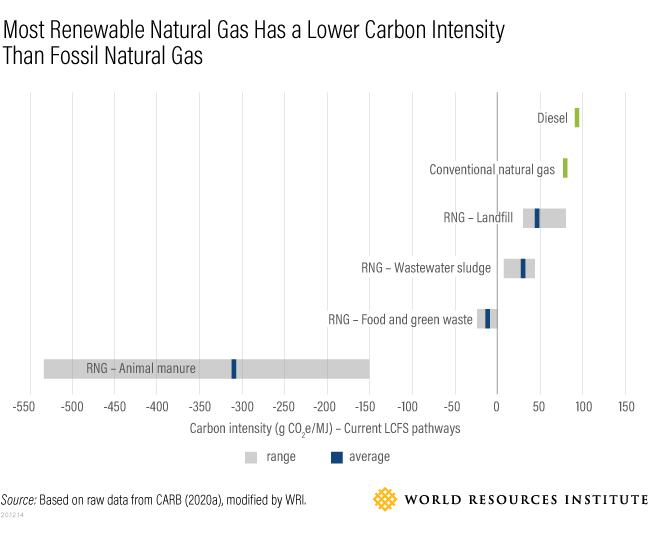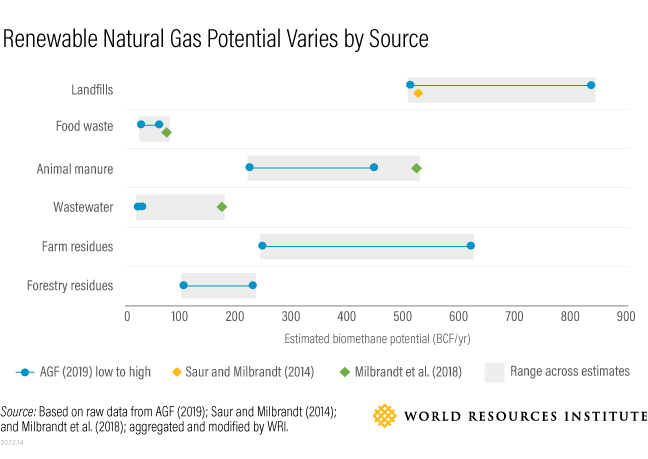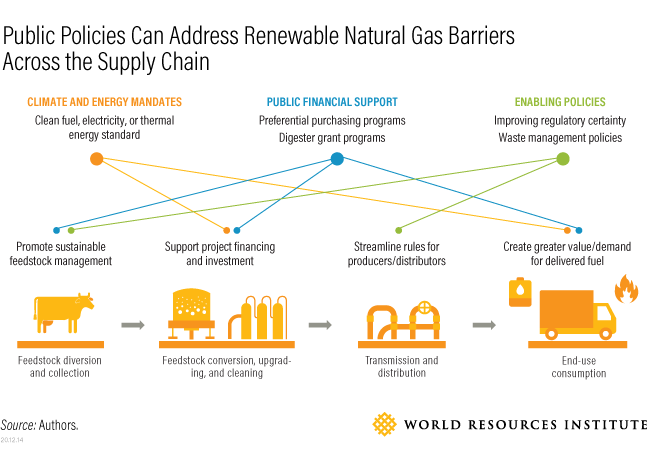The production and use of renewable natural gas made from organic waste is growing rapidly in the United States. The number of production facilities in the country — which convert landfill waste, animal manure, wastewater, food waste and other organic feedstocks into fuel that is interchangeable with fossil natural gas — has grown from approximately 40 prior to 2014 to nearly 160 today.
Due to the potential benefits of renewable natural gas as an alternative to fossil fuels, a handful of states including California, Washington and Oregon have integrated it into climate goals. Both state and national assessments find that sufficient amounts of the waste-derived fuel could be produced to displace as much as 4-7% of current fossil gas consumption, while delivering other co-benefits related to waste management.
However, policymakers across the country still face questions on the extent to which renewable natural gas can help states meet ambitious climate change targets.
A new research paper by WRI examines the potential of renewable natural gas as a climate strategy. The paper provides detailed guidance on assessing renewable natural gas potential and climate impacts, evaluating its role in decarbonization, and identifying effective policy frameworks for project development.
Overall, the paper finds that renewable natural gas could play a unique and valuable role in state decarbonization efforts. However, benefits vary and should be evaluated case by case in order to deploy resources sustainably, efficiently and in a manner that complements other greenhouse gas reduction measures.
1. What Are the Biggest Sources of Renewable Natural Gas?
Common sources of renewable natural gas (also referred to as biomethane or upgraded biogas) include landfills, animal manure, food scraps and wastewater sludge. Bacteria break down organic matter in these “wet” wastes and produce methane, carbon dioxide, and other gases and solids through a process referred to as anaerobic digestion. The resulting biogas can then be processed or “upgraded” to get rid of impurities, so that it is nearly pure methane.
Currently, landfills account for over 90% of renewable natural gas production, and are often more economical relative to other waste streams. Many landfills already have methane collection mechanisms, and they tend to produce more gas in a concentrated area.
Less concentrated resources, such as animal manure and food waste, have become growing sources of renewable natural gas, but face more economic barriers and may require additional policy support or incentives.
Renewable natural gas may also be derived from “dry” organic wastes in the form of agricultural and forestry residues — such as corn plants after harvest, grass clippings, tree trimmings and nut shells. These feedstocks have significant energy potential on par with or exceeding wet wastes, but at present are not significant sources of renewable natural gas due to technological hurdles still being overcome.
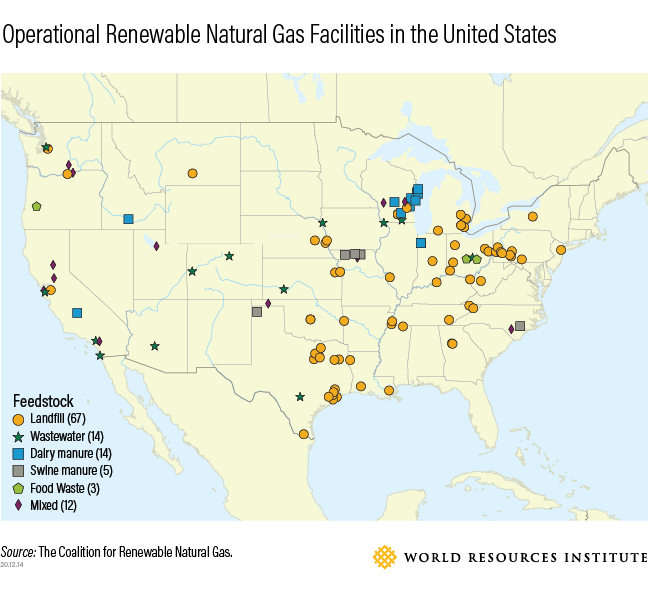
2. How Is Renewable Natural Gas Used, and What Are the Climate Impacts?
At present, renewable natural gas is most often used as a transportation fuel, particularly as a substitute for diesel in heavy-duty vehicles. This trend has been driven largely by mandates, such as California’s Low Carbon Fuel Standard and the federal Renewable Fuel Standard, which credit the environmental attributes of renewable natural gas production.
However, given its interchangeability with natural gas, renewable natural gas may be used in a wide array of applications. Its potential as a heat source in existing buildings or in industrial applications in particular has seen growing interest in recent years.
Greenhouse gas emissions benefits associated with renewable natural gas production and use primarily stem from:
- Avoiding greenhouse gas emissions that would otherwise occur under typical waste management practices (for example, methane emissions from animal manure in uncovered lagoons); and
- Displacing fossil fuel use (for example, in heavy-duty vehicles that would otherwise use diesel fuel).
No two projects are exactly alike, since a wide array of feedstocks, technologies and uses are possible. However, prior WRI research found that renewable natural gas is most likely to yield meaningful greenhouse gas emissions benefits when two basic conditions are met:
- The gas is made from actual waste (as opposed to crops grown specifically for fuel, or diverted biomass that has other uses); and
- Its production and use results in a net reduction in methane emissions.
To calculate the greenhouse gas emissions impacts of renewable natural gas, experts typically use a lifecycle approach to quantify all sources of emissions from a given project — including energy used to convert organic waste to biomethane, and any methane leaks along the supply chain — as well as all avoided emissions resulting from the project.
In many cases, renewable natural gas avoids more emissions than it generates, leading to a net-negative carbon intensity (in terms of carbon dioxide emissions avoided per quantity of fuel consumed).
Importantly, lifecycle accounting approaches are not without limitations.
Tallying up all emissions sources and credits for a given project requires rigorous data collection, and the approach relies on assumptions that may be uncertain or change over time (e.g. that methane emissions would otherwise occur at a farm or landfill). However, when applied effectively, the approach can help decision-makers identify projects that yield the most significant climate benefits.
3. What Are Common Concerns About Renewable Natural Gas?
As the production and use of renewable natural gas has grown, so too have concerns about whether it truly has meaningful climate and environmental benefits. Renewable natural gas is primarily composed of methane, which emits carbon dioxide when burned as fuel. The release of this carbon is typically offset by other benefits as described above. However, since methane itself is a greenhouse gas 84-86 times more powerful than carbon dioxide (on a 20-year timescale), any methane leaks along the RNG supply chain prior to combustion risks undermining potential climate benefits.
Because renewable natural gas uses some of the same infrastructure (such as pipelines and fueling stations) as fossil natural gas, additional concerns include the risk of expanding or “locking in” infrastructure that enables more fossil fuel use. In addition, there are concerns that alternative uses for certain organic wastes may be more beneficial.
To minimize any risk of projects doing more harm than good, renewable natural gas should be evaluated case by case. Important questions to ask include:
- Does the production of renewable natural gas capture methane emissions that would otherwise have been emitted into the atmosphere?
- Does RNG production solve waste management problems, or yield co-benefits alongside emissions benefits?
- What are competing uses or management practices for the waste streams used, and does renewable natural gas complement solutions such as composting, animal feed or soil fertilizer?
- Does the project avoid building new fossil fuel-based infrastructure?
If the answer to these questions is “yes,” then RNG projects may very well contribute to global and local climate and environmental goals. However, the answers may not always be straightforward.
To address these questions, WRI’s paper walks readers through common approaches, evaluation metrics and considerations by feedstock that they can use to conduct a local assessment.
4. How Much Renewable Natural Gas Can the US Actually Produce?
While the United States generates millions of tons of food scraps, sewage, oils and greases, livestock manure and other waste each year, these waste streams are finite, as is the amount of renewable natural gas that may be produced from them.
And the United States is already using many of these waste streams. For example, wastewater facilities often burn biogas in a generator to supply heat and power to the facility, and food waste may be diverted to composting or animal feed.
However, significant unutilized potential still exists, and some of these wastes can be converted to renewable natural gas in a way that maintains or enhances existing applications. For example, leftover solid byproducts from anaerobic digestion may be used as animal bedding or a nutrient-rich soil amendment.
Estimates suggest that 780-1,400 billion cubic feet (BCF) of biomethane (equivalent to 4-7% of present-day natural gas consumption in the United States) could be produced from sources requiring anaerobic digestion, such as landfills and manure.
When also including crop and forestry residues, researchers estimate that as much as 2,200 BCF could be produced (11% of natural gas consumption). However, the conversion of these wastes relies on a nascent technology known as thermal gasification, and it may be more beneficial to use them to produce hydrogen.
5. What Role Can Renewable Natural Gas Play in Decarbonizing the Economy?
Some criticism of renewable natural gas as a climate strategy stems from concern that it may “distract” from other vital decarbonization strategies such as electrification and adding renewable generation to the electric grid. Indeed, renewable natural gas derived from organic wastes has relatively modest potential to reduce emissions compared to these strategies, and on its own cannot displace enough fossil fuels to fully decarbonize any one sector of the economy.
Nonetheless, renewable natural gas can make meaningful decarbonization contributions to the extent that it results in a net reduction in methane emissions, and it displaces fossil fuel use in otherwise hard-to-abate sectors. Rather than viewing renewable natural gas as a substitute for other decarbonization strategies, it is important to consider the alternative fuel’s comparative advantages and potential to complement other solutions.
For example, the ability to use renewable natural gas in existing gas infrastructure may make it a cost-effective option in the near term even as electrification efforts accelerate. Industries requiring high-density, combustion-based fuel, such as heavy-duty transportation and industrial heating, may be particularly good candidates for renewable natural gas. These considerations can help decisionmakers identify opportunities for renewable natural gas to contribute to long-term decarbonization.
6. What Are the Biggest Obstacles to Deploying Renewable Natural Gas?
Renewable natural gas faces many barriers to production — including up-front project costs; feedstock availability; and regulatory, operational and market risks. Installing equipment and connecting pipelines can cost projects millions of dollars up front.
Feedstock availability is affected by the seasonal variability of waste production. For example, crop residues are only available at the end of the growing season. Furthermore, competing uses can affect feedstock availability, such as the demand for crop residues for soil retention and enhancing soil nutrients.
Related Articles: 4 Charts Explain Greenhouse Gas Emissions by Countries and Sectors | Resource Considerations and Costs for Carbon Removal
Risks associated with project development also increase the effect of up-front project costs, as these risks dampen future revenue expectations. Regulatory risk from an uncertain policy landscape deters new projects, since a regulatory change could alter funding levels or specifications for qualifying projects.
Shifting political will can result in the defunding of programs or the repeal of legislation. Many policies rely on regular funding extensions through federal appropriations bills. Finally, some policies contain conditional sunsetting provisions which establish conditions — such as the amount of funding provided or the number of projects funded — that when satisfied, result in policies being halted.
Operational risks include feedstock inconsistency — the specific composition of waste in feedstocks (from landfills, for example) varies over time or between different sources, which can affect the equipment in RNG facilities.
Finally, market risk due to fluctuating credit and commodity prices leads to uncertain revenue from renewable natural gas sales. From 2016 to 2019, credit prices for California’s Low-Carbon Fuel Standard doubled, while credit prices under the federal Renewable Fuel Standard fell by two-thirds and natural gas prices fell by one-third.
7. How Can US States Enact Policies and Measures to Deploy Renewable Natural Gas?
A given state or region may very well have practical opportunities for renewable natural gas deployment that yield significant climate benefits. However, the impact of various policy options and how they link to current market barriers along the waste-to-energy supply chain are not often well understood.
For example, waste management regulations such as food waste bans in Massachusetts and Connecticut may improve feedstock availability for digester projects, while clean fuel standards such as those in Oregon and California may create greater value for the environmental attributes of renewable natural gas production.
The right mix of incentives and other support mechanisms will depend on local political and economic context, feedstock availability and policy priorities.
While there is no one-size-fits all approach, effective renewable natural gas deployment is typically the product of a number of overlapping policy support mechanisms that address market barriers and simultaneously promote climate and environmental priorities. Viewing these factors together can therefore guide resource development that is efficient, appropriate for local economic and political priorities, and environmentally beneficial.
— —
About the Authors: Tom Cyrs is a Research Associate with the WRI United States Program, where he leads research efforts to assess and quantify the impact of state and local level climate policies. John Feldmann works with the WRI U.S. team as a Research Analyst.
Editor’s Notes: The opinions expressed here by Impakter.com columnists are their own, not those of Impakter.com. — In the Featured Photo: Renewable natural gas facilities turn organic waste into a fossil fuel alternative. Featured Photo Credit: John Fricker/Geograph UK.
A previous version of this blog cited a smaller estimate of the number of renewable natural gas facilities in the United States. This number has been updated according to more recent data (as of January 2021).


